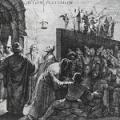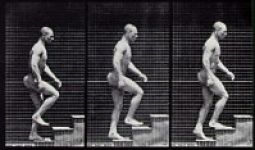27 - Second Thoughts: Plato's Parmenides and the Forms
Plato sets out criticisms against his own theory of Forms in the "Parmenides". In this episode Peter looks at the criticisms, including the Third Man Argument, and asks what Plato wants us to conclude from them.
Themes:
• MM McCabe, Plato's Individuals (Princeton: Princeton University Press, 1994), chs. 3 and 4.
• C. Meinwald, "Good-bye to the Third Man," in R. Kraut (ed.), The Cambridge Companion to Plato (Cambridge: Cambridge University Press, 1992), 365-396.
• C. Strang, "Plato and the Third Man," In G. Vlastos (ed.), Plato: a Collection of Critical Essays, vol.1, Metaphysics and Epistemology (London: Macmillan, 1972).
• G. Vlastos, "The Third Man argument in the Parmenides ," in R.E. Allen (ed.), Studies in Plato's Metaphysics (London: Routledge, 1965).







Comments
Form, the Observer and Geometry.
Having just finished listening to the Plato section I am left with a rather disappointing view about Plato's Forms. From my understanding so far it would seem that through his idea of Forms any and all things are inherently Objective, that is, there is a natural/universal standard for any quality that can be attributed to anything, these being Beauty, Largeness, Hotness, Blueness… . Meaning is therefore extracted from the Form. Did I miss it in the podcast, or is this point not touched on in either Plato's writings or in the podcast, but is there any discussion on the duality of things? That is describing something as having the form of objectively contradictory Forms. Most simply Largeness and Smallness at the same time?
As a thought experiment, it can be shown how by beginning with a large rock, it has the form of largeness, but if the rock is broken apart to make it smaller I would eventually arrive at a small rock, which has the form of smallness. How can it have the form of largeness in the beginning and then smallness afterwards?
A simple argument could easily refute this by saying it is no longer the same rock, a la the analogy to the flowing river.
Now if I have a rock with a property of largeness, but change the observer, i.e. from a person to an ant, or from an adult to a child. The new observer describes the rock by its opposite quality of smallness. What is the truth in Plato's eyes, is it both large and small, or is someone wrong?
This seems to me to be a basic question of proportions, that frankly is at the heart of Geometry. Which is in simple terms the study of proportions of objects. Having heard so much of Plato and his view of Geometry, this seems like it would be an oversight by Plato.
This also highlights different categories of Forms, between measurable quantities, such as Hot/Cold, and subjective qualities Beauty, Courage, etc. Does Plato acknowledge this in any way, or was the belief that any mischaracterization of the Form attributed to something lies in the Philosopher making a mistake and not on the Form changing? Because if the Form changes between observers how can anything be known.
Or, merging some non-Euclidean Geometry with the allegory of the cave, did Plato view the interaction between Forms and reality as akin to projective geometry, where the interpretation of an objects relation to its form is changed by the "observation plane," changing the angle of the screen and that changes the Forms manifestation to the observer?
In reply to Form, the Observer and Geometry. by Thomas Kubail
Forms
Well I wrote these episodes more than a decade ago but I am sure they cover the point about the same thing participating in more than one Form, like something being both large and small at different times or from different perspectives. Plato makes this point himself in both the Phaedo and Republic, and uses it to argue for Forms: the particulars that participate in contrary Forms cannot be the locus of the nature itself, which should rule out its contrary.
The issue of mathematics is more tricky: Plato clearly thought about this a lot as is clear from some dialogues (like the Timaeus) but it is very unclear what if any his settled views were. His immediate followers who are covered in a later episode also relate mathematical objects to Forms or even identify them.
Add new comment